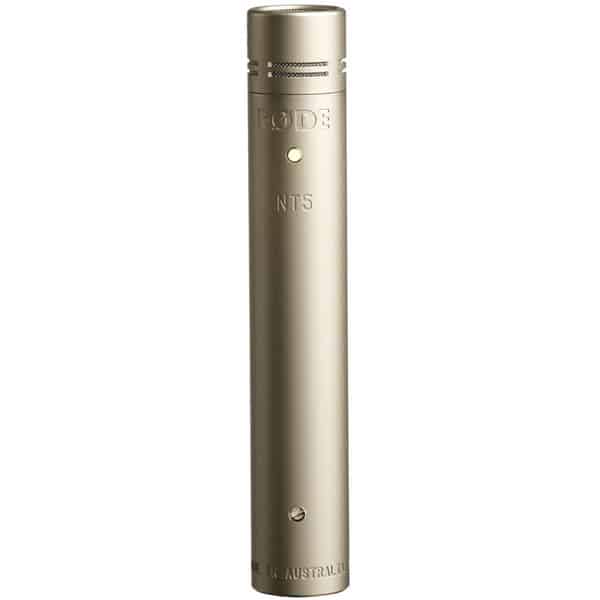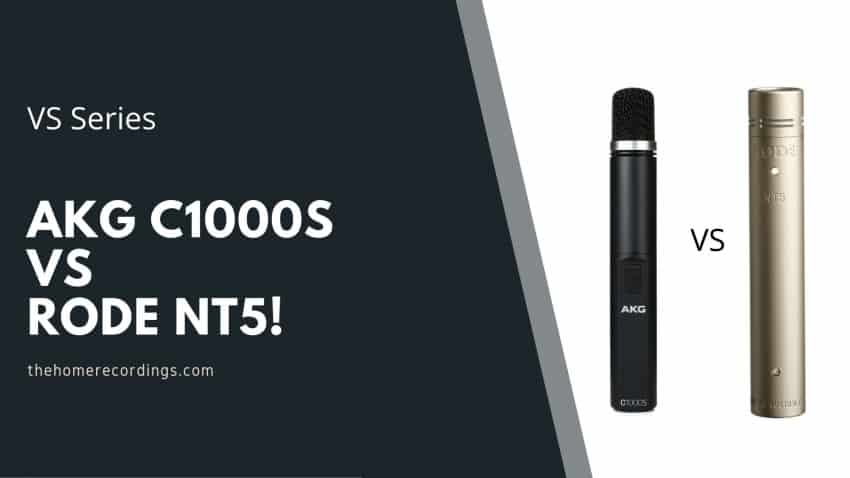Last updated on December 29th, 2023 at 09:56 pm
In this article, I will be going over the differences between the AKG C1000s and the Rode NT5, which are two of the most used small-diaphragm condenser microphones in existence.
I did include the Rode NT5 in another post about the best microphones under $300 that you should definitely check out as well!
So, without any further ado, let’s get into the differences and then I will give you a complete overview of these microphones, their features, when you should use one or the other, and more!
AKG C1000S and Rode NT5 differences
Both are small-diaphragm condenser microphones with a cardioid polar pattern, but the Rode NT5 has a flatter- and overall better sound than the AKG C1000S, since the AKG tends to sound a lot brighter/shriller, which makes it the better choice most of the times. However, the AKG C1000S gives you the option of switching it to a hypercardioid polar pattern and it also features a PAD and a High Pass filter, which the NT5 doesn’t.
If this information is enough for you, absolutely fantastic! However, for those of you who want to learn more about the differences between these mics and when you should use one or the other, keep on reading since there’s a lot of really useful information in this post!
AKG C1000S

AKG released the C1000S in the 80’s with the intention of providing audio enthusiasts with an affordable and versatile condenser for recordings and the stage.
Although this microphone has sold a ton and can be found everywhere from Tulsa to Timbuktu, it’s been extremely polarizing, some claiming it as a workhorse, others labelling it a lazy donkey! This microphone is mainly used for acoustic guitars and overheads but can be thrown at vocals or even a rack-tom.
The body of the C1000S is made of robust and smooth metal and has a black matte finish to it. It’s not a very heavy microphone to hold, but it is quite long which gives it a clunky feel.
It’s a small diaphragm condenser microphone which can operate off either 48V phantom power or 2 AA batteries. It features an on/off switch with an LED that indicates the status of your batteries. It will temporarily flash if your batteries are in good nick, stay lit if you have less than an hour of juice left, or not light at all if they are dead.
It has a cardioid polar pattern, with the option of switching it to a hypercardioid with its PPC1000 converter.
AKG have also offered the option of using their PB1000 presence boost adapter to add a 5dB boost between 5kHz and 9kHz, which is designed for those dedicated to dialogue recording.
It comes with an attachable foam windscreen and has even more foam padding inside its grill, the combination of the two offers up a dignified protection from plosives.
This mic also comes with a high-pass filter switch which rolls off any frequencies below 80Hz. The C1000S also includes a pad switch which attenuates all incoming sounds by 10dB.
How does it sound?
The C1000S certainly isn’t the “Swiss army knife of microphones” AKG markets it as, if you need clarity and realism from your capsule this tool will not suffice. On the other hand, it also does not deserve the malignment it has received on audio forums throughout the web, it is more than adequate for those entering the recording realm and can serve an unsung role in many a mix.
The C1000S has a hollow sounding low end due to its frequency response featuring quite the upward slope on the road to 200Hz. This along with its bass-cut feature could come in handy for those looking to close mic while minimizing the proximity effect but will have people who are all about that bass reaching for an EQ every time.
From 300Hz to 2kHz is where this microphone shines and where it sounds the most articulate and round. Although lacking in the rest of its frequency response, this area provides enough fullness to push this mic over the finish line.
Its upper-mids past 3kHz on the other hand come off as edged and brittle, this is where the mic has gained a reputation for testing engineers’ patience.
There really is no sparkle from the high frequencies at all, so those who live in the brilliance band will be left with their heads in their hands.
In my opinion, the C1000S sounds lovely on an acoustic guitar as it really brings out that body sound of the instrument. Although it’s not ideal for presenting a guitar as a lead star in a song, it’s perfect for when an acoustic is playing a backing role.
As an overhead mic it tends to make cymbals too glassy in the upper-mids and is completely inept with the highs. There are undoubtedly cymbals out there that this mic will suit down to the ground, but just don’t hold your breath while you’re looking for them.
With proper mic technique and their presence booster it can make dialogue sound clear and more than passable for a budget burdened Podcast. However, due to it’s high-self noise, hip indie filmmakers on the rise might find it a liability.
Singers will find this mic to be quite unflattering if they have used a vocal purposed condenser in the past. It sounds quite dull and cold in most places and a bit too raunchy in the low-mids, it can come off as unprofessional even to novice ears.
What comes in the box?
- AKG C1000S Microphone
- PPC1000 polar pattern converter
- PB1000 presence boost adapter
- W1001 windscreen
- SA63 stand adapter
- Microphone carry bag
Specifications
| Microphone Type | Small diaphragm condenser |
| Polar Pattern | Cardioid, hypercardioid with adapter |
| Frequency Response | 50Hz-20kHz |
| Output Impedance | 200Ω |
| Maximum SPL | 137dBSPL |
| Sensitivity | 6mV/Pa (-44dBV) |
| Self-Noise | 21 Db-A |
Find out more about the AKg C1000S here:
- AKG C1000S: Amazon, Sweetwater.
Rode NT5

The NT5 was released by Australia’s Rode back in 2002 and has sprung from down under to pop up in project studios everywhere ever since. This microphone is commonly sold as a matched pair for stereo recordings but is also available as a lone ranger for those who aren’t in need of a duo.
It’s mainly designed for acoustic instruments and overheads, but a lot of low-budget filmmakers have taken a shine to using it as an indoor boom mic.
The NT5 is a small diaphragm condenser pencil style microphone. It’s compact and light with a sleek and strong satin-nickel plated body. This microphone requires 48V phantom power to operate and does not feature an internal battery option. It also does not include any hidden pads, filters, or switches of any kind, what you see is what you get!
It contains a gold sputtered diaphragm which captures a full frequency response range of 20Hz to 20kHz using a cardioid pickup pattern. The capsule can be removed and replaced with Rode’s separately sold NT45-O omnidirectional capsule.
Inside the NT5 you will find surface mounted circuit components which include a J-FET impedance convertor doing a little alternating current abracadabra.
How does it sound?
Rode’s NT5 holds its own in with other small diaphragms out there and can capture a warm picture, albeit lacking in detail compared to other pencil mics in the big league. This little RODENT’s nibble is versatile, it uses subtle nuances in its frequency response to paint a low-key but reliable picture.
Its response slightly pulls back around 20Hz-100Hz to offer up a restrained but cozy and charming low end.
The NT5’s lower-mids have a mild controlled bounce from 100Hz to 200Hz, then from 400Hz to 1kHz a nice little sweet spot of neutrality arrives. Further up again, its upper-mids have a somewhat hollow and punitive reaction.
This microphone’s high frequency response is its standout zone, it really adds some gleam and glisten to your scream and listen.
Rode’s NT5 sounds really poised on an acoustic guitar, but with a slight longing for a little more meat on its bone up in the upper-mids. There are no over-the-top frequency exaggerations, just a moderate resolution snapshot of your strumming.
As an overhead it adds the perfect pinch of brightness to the cymbals, making them really sing and sizzle.
Dialogue recorded through the NT5 has a nice subtle crispiness to it that would suit many a voice-acting vagabond.
Singing wise you will find this adequately agile, but it could use a tad more warmth on offer from the lows and bite from the upper-mids.
What comes in the box?
- Rode NT5 microphone
- WS5 windshield
- RM5 stand adapter
- ZP1 microphone carry pouch
- Hard case when purchased as matched pair
- 10-year warranty card
Specifications
| Microphone Type | Small diaphragm condenser |
| Polar Pattern | Cardioid |
| Frequency Response | 20Hz – 20kHz |
| Output Impedance | 100Ω |
| Maximum SPL | 143dBSPL |
| Sensitivity | 6 mV/Pa |
| Self-Noise | 16dBa |
Find out more about the Rode NT5 here:
- Rode NT5: Amazon, Sweetwater.
Which one should you choose?
Don’t let the negative nellies on all of those audio forums fool you, both these microphones are great and will get you some amazing results. People complain they don’t compare to the quality of a Neumann KM 184, that’s like telling the person who painted your house for next to nothing that he’s no Michelangelo!
Personally, if you were involved in a session with a lot of instrumentation plus an acoustic guitar, I would reach for the C1000S, as it will allow the strummers presence to be known without overcrowding the mix. Although it’s not a “swiss army knife” it is a cheap “doesn’t hurt to have a few lying around” kind of microphone which people in live sound reinforcement will regularly find a spot for on stage.
The NT5 will offer a more accurate and flatter image of an acoustic guitar, so if it’s mainly just your singing and six strings that are in business, then this will be your go to.
If you’re looking for something to throw on vocals or use as an overhead, I would pick the NT5. That high end sparkle right out the gate just saves unnecessary EQ time that a C1000S would require.
So, if I had to recommend one of these microphones, I would recommend Rode’s NT5. Pretty much everything goes in favor of the NT5. The compact size, the professional feel, and of course its capsule is just capable of more than the C1000S. Although AKG’s C1000S offers more included accessories and fun little switches, Rode just offers more where it counts, the sound!
I hope this information was useful!
Have a great day!
